Nov
7
Last week I attended a, let’s see if I can get this right, “California Milk Advisory Board Mom to Mom Event” in Modesto. Ketchum PR partnered with the advisory board to send a group of mom bloggers to California to promote dairy through a couple of farm tours and other events. I said yes to the invite because 1) it sounded interesting, and 2) I heard there would be, like, a shitload of cheese.
(Just so you know, they paid for our travel and fed us, but there was no financial incentive or blogging requirements or anything like that.)
We arrived in SFO on Wednesday and drove a long long way through a lot of brownish scenery to Modesto, where we spent the night. Thursday we spent most of the day touring two different dairy farms and talking to various folks before heading back to San Francisco and flying back home Friday morning.
It was a fast trip, made possible on my part only by my in-laws being willing to stay with the kids while I was gone (something I’d forgotten about: no daycare means no traveling without a fairly complex series of arrangements), and I could tell you about the people I met or the 10 trillion calories of dairy products I ate, but I think I’d rather tell you some of the things I came home thinking about.
One issue I was interested in hearing about is the use of hormones in dairy cows. Recombinant bovine somatotropin, or rBST, is an artificial growth hormone that increases milk yield in lactating cows. The commercial name of rBST is Posilac, and is trademarked by Monsanto.
(Thing to make you go hmmmmmm: Monsanto Inc. is the only company approved by the FDA to manufacture and sell rbST within the United States.)
The first farm we visited used rBST, the second farm didn’t. They explained this simply as a farm management choice, and I imagine that there’s a considerable amount of financial planning that goes into the decision to use rBST or not. rBST costs probably include the treatment itself, increased labor costs, feed costs, etc, which all must be weighed against the potential gain of milk production.
There is information out there that will tell you rBST is bad for human health. There’s information that says otherwise. There’s neutral informationyou can read in order to understand what rBST is and how it works.
The use of rBST is a pretty complicated issue that’s all tangled up in profit, environmental impact, marketing ploys, and opinion. I’m not 100% sure how I feel about rBST, but I haven’t gone out of my way to purchase the more expensive “hormone free” milk in the past, and I doubt I will going forward. I do feel a lot more informed about it now, and plan to continue reading up on it.
On that note, we did talk a bit about the “antibiotic free” label you sometimes see on milk cartons. What we were told, and what I’ve read since, is that any antibiotics given to cows are intended to treat a specific disease, like mastitis. Sick cows are separated, but on the off chance milk from an antibiotic-dosed cow is collected, it’s caught at the processing facility where all milk is tested before they accept a farm’s tank. If any tainted milk is found, the entire truckload is rejected and the farmer with the offending milk has to pay for everyone’s loss.
Bottom line is: ALL milk is antibiotic free, not just the kind with the fancy label that costs $4 more per gallon.
I was also interested in how the cows are treated on a dairy farm. I think I had generally imagined there were two main types of farms: the small independent places with cows strolling around lush green pesticide-free fields, and the giant corporate hellholes with miserable cows kept immobilized in their own filth.
These farms we visited were quite large, at least 800 cows on the second one and I forget how many at the first. These are the farms that are putting milk on your table, if you’re buying from a large cooperative like Darigold in the Seattle area. They didn’t really look anything like I’d imagined, from the owners (young, with small children) to the facilities (modern and efficient, but not remotely creepy).
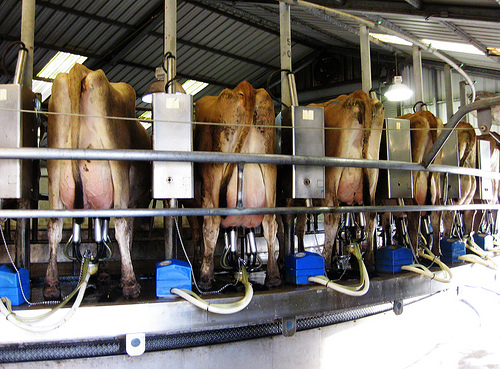
A rotating carousel milking station.
Both farms had cows in various holding pens, they weren’t roaming around a pasture or anything. Cows were together in large groups, but with plenty of room and in clean facilities. (Well, relatively clean. Cows do poop a lot, after all.) I did feel uncomfortable when I saw the calf pens, where the very youngest cows are kept. These are small individual containers and it’s hard not to look at a baby cow in there and think cage.
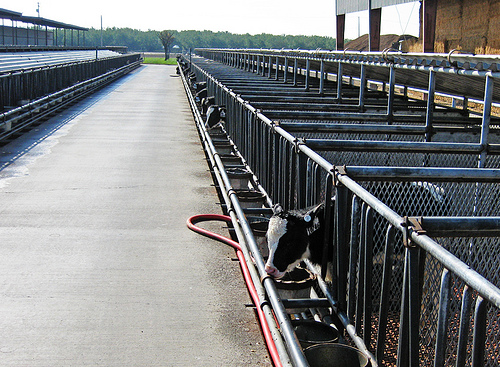
This isn’t done to be cruel, though. It’s about efficiency, like everything else on a modern dairy farm—disease prevention, improved nutrition and growth.
So, I don’t know. I prefer to think of baby cows hanging out with their mothers and wandering the fields, but the reality isn’t as awful as I’d imagined either. Cows are very . . . zenlike, somehow. You don’t get the feeling that they’re dying to get out of their holding pen and go for a hike, you know what I mean? All the cows we saw seemed quite content—mildly curious in the group of women frantically TwitPic’ing their every move, but generally just sort of there, doing their Cow Thing.
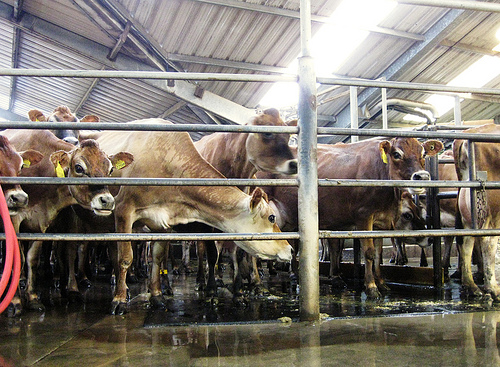
Cows entering a milking station. I liked these Jersey cows best, with their giant Bambi eyes.
Our PR team arranged for us to meet a couple of the young veterinarians that work with the farmers, and man, I enjoyed that. These girls are really passionate about their line of work. Vet schools are super hard to get into—I think they said there were only 27 nationwide?—and I doubt anyone goes into it for any other reason than a deep love of animals and farming. One of the vets showed us a slideshow of her typical work day (starting at 4:30 AM, lord), including photos of the awesome freaky strap-on portable cow-ultrasound machines they wear that look like something out of Ghostbusters, and that was very cool.
(As a kid, I was obsessed with those James Herriot books. I wanted to ask these young vets if they’d ever read them but was afraid it would make me seem Ancient and Crusty.)
We also talked with a California dairy farm sustainability expert, and while I can’t begin to remember all the environmental initiatives they’ve got underway, it was impressive. One interesting fact: since 1944, U.S. dairy farms have reduced the carbon footprint of milk by 63%. This is essentially thanks to all the efficiency improvements farms have made over the years, which results in more milk from fewer cows. Total dairy herds U.S.-wide used to be 25.6 million, down now to 9.3 million cows.
Overall, there were a lot of really fun things about the trip. There was the spectacular cheese-tasting dinner they treated us to on Wednesday night, hosted by a woman who was an absolute joy to listen to. There was the chance to get to know a group of bloggers I’d never have met otherwise, and of course the luxurious business of waking up in a hotel room with no diapers in sight.
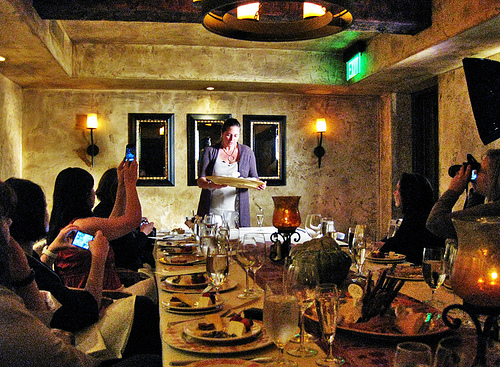
The thing I appreciated the most, though, was the chance to feel a bit more connected to one of the foods I buy nearly every day. It was such a treat to meet the farm families and have the opportunity to experience a tiny bit of that lifestyle. It seems like a fair number of commercial dairy farms are open to tours, and I can’t recommend it enough if you have one in your area. Go check it out for yourself, ask questions, see how it all works. It’s a pretty amazing process.
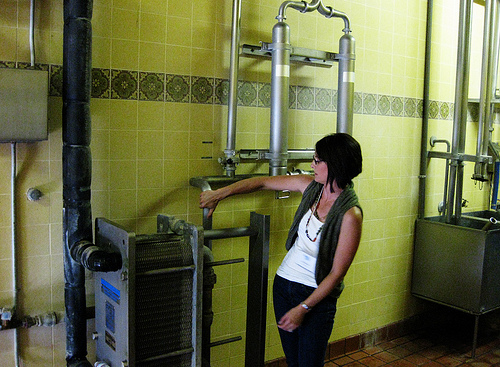
Ellen Durrer of the Durrer family farm, showing how milk enters a rapid-cooling area before going into a storage tank.
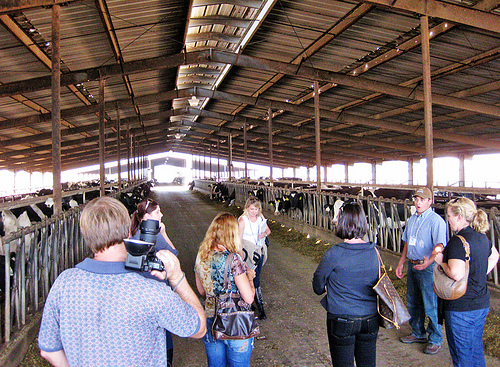
Chris Durrer talking about feed and housing.
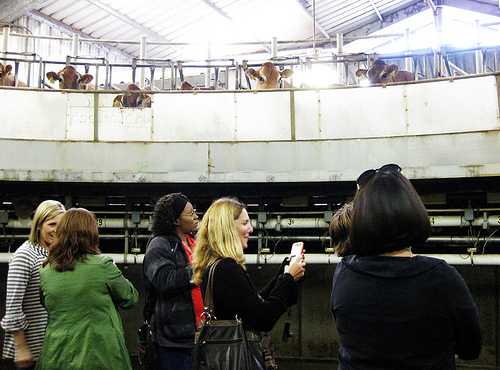
Bloggers: we will totally take pictures of ANYTHING.
Lastly, a tiny tidbit from the never-to-be-forgotten Wednesday night dinner: get yourself a gingersnap, crumble some Point Reyes blue cheese on top. Eat. DIE HAPPY.


I’m out of league here. Too much brain power on display!